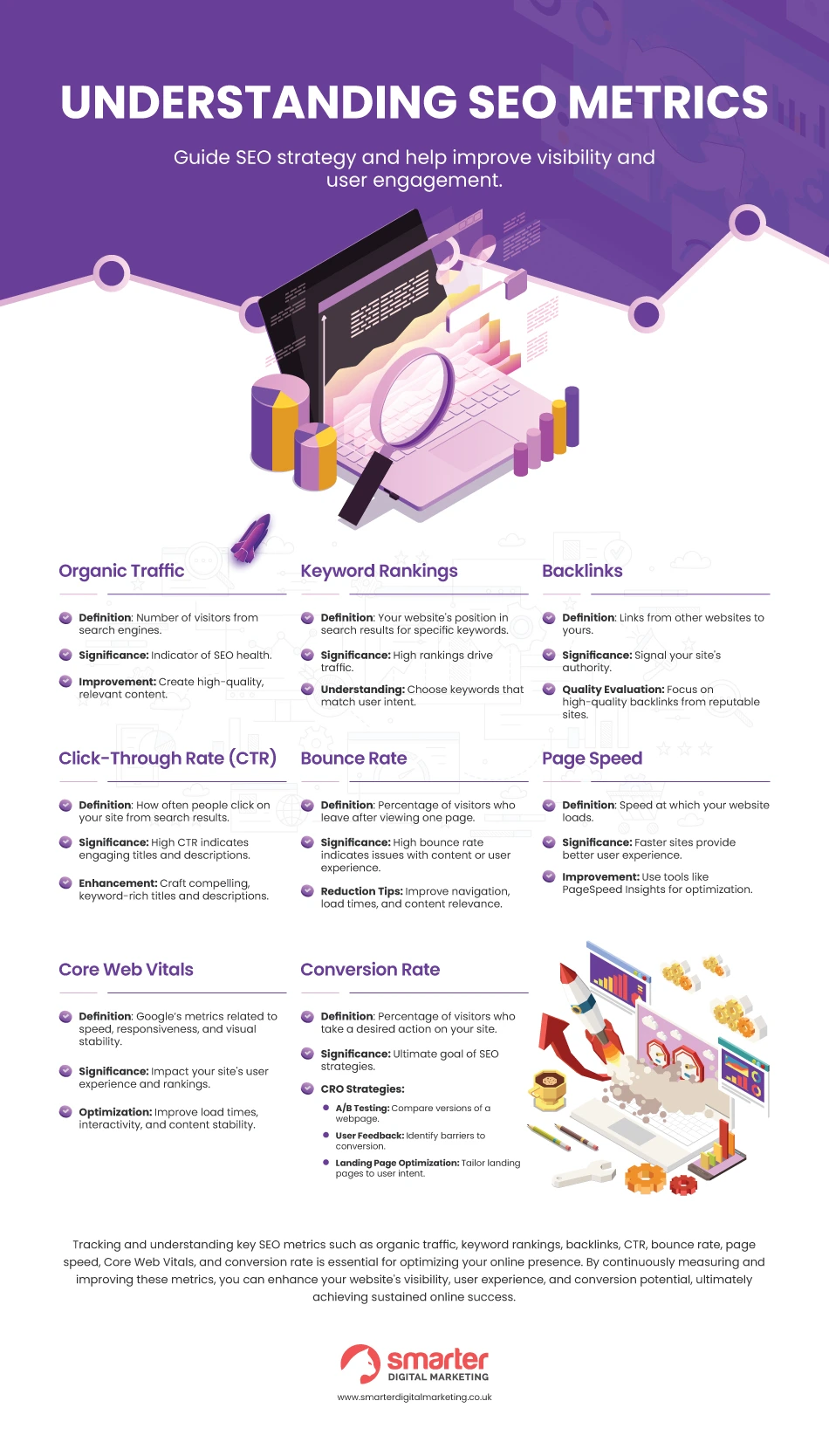In today’s digital age, understanding and leveraging SEO metrics is crucial for anyone looking to enhance their online presence, especially in the competitive market of the United Kingdom. SEO, or Search Engine Optimization, is the art and science of making your website more visible and attractive to search engines like Google. But it’s not just about throwing keywords onto a page; it’s about understanding the data behind your website’s performance and using it to make informed decisions.
Key Takeaways
- SEO metrics provide invaluable insights into your website’s performance.
- Tracking the right metrics can significantly improve your organic traffic and user engagement.
- Keyword rankings, backlinks, and page speed are among the top metrics to monitor.
- Understanding and improving these metrics can lead to better search engine rankings and user experience, ultimately boosting your conversion rate.
SEO metrics are more than just numbers; they tell the story of your website’s relationship with its users and its standing in the vast internet ecosystem. By diving deep into these metrics, you can uncover weaknesses, highlight strengths, and chart a path to sustained online success.

Understanding the Importance of SEO Metrics
In the realm of digital marketing, SEO metrics serve as the compass that guides your strategy. They offer a clear view of where you stand in search engine results pages (SERPs), how users interact with your content, and what you can do to improve your visibility and engagement. For businesses in the UK, where the online market is highly competitive, these insights are gold dust.
The Evolution of SEO Metrics Over Time
SEO is not static. As search engines evolve, so do the metrics we rely on to gauge our success. Early SEO strategies focused heavily on keyword density and backlinks, but today’s SEO is more nuanced, emphasizing user experience, content relevance, and mobile optimization.
Core SEO Metrics to Track

Organic Traffic: The Lifeline of SEO
Organic traffic is the number of visitors coming to your site through search engines, and it’s a fundamental indicator of your SEO health. A steady increase in organic traffic suggests that your SEO efforts are paying off, leading to more visibility and potential conversions.
How to Measure and Improve
You can track organic traffic using tools like Google Analytics. To improve it, focus on creating high-quality, relevant content and optimizing your website for keywords that matter to your audience.
Keyword Rankings: Tracking Your SEO Footprint
Your keyword rankings indicate where your website lands in search results for specific keywords. High rankings can drive significant traffic to your site, making this metric a critical focus for any SEO strategy.
Understanding Keyword Relevance
Choosing the right keywords is about understanding your audience’s search intent. Tools like Google’s Keyword Planner can help you identify high-value keywords relevant to your UK audience.
Backlinks: The Backbone of SEO Authority
Backlinks — links from other websites to yours — signal to search engines that your content is valuable and authoritative. The quality and quantity of backlinks can significantly affect your SEO rankings.
Evaluating the Quality of Backlinks
Not all backlinks are created equal. Focus on earning high-quality backlinks from reputable sites within your industry. Tools like Ahrefs and Moz can help you analyze your backlink profile.
Click-Through Rate (CTR): Understanding User Engagement
CTR measures how often people who see your website in search results decide to click on it. A high CTR means your page title and meta description are compelling and relevant to search queries.
Strategies to Enhance CTR
To improve your CTR, craft engaging, keyword-rich titles and descriptions that accurately reflect the content of your page. A/B testing can help you refine these elements to maximize clicks.

Bounce Rate: Analyzing User Experience (UX)
Bounce rate is the percentage of visitors who leave your site after viewing only one page. A high bounce rate could indicate that your site’s content or UX is not meeting users’ expectations.
Tips for Reducing Bounce Rate
Improving your website’s navigation, speeding up load times, and ensuring your content is engaging and relevant can help reduce your bounce rate and keep visitors on your site longer.
Page Speed: The Need for Speed in SEO
In the fast-paced online world, page speed is critical. Google has made it clear that faster websites provide a better user experience and, therefore, deserve higher rankings.
Impact of Page Speed on Rankings
A slow-loading website can frustrate users and drive them away, negatively impacting your SEO. Google’s PageSpeed Insights tool can help you identify and fix speed issues.
Core Web Vitals: Google’s UX Metrics
Google’s Core Web Vitals are a set of metrics related to speed, responsiveness, and visual stability. They play a crucial role in determining your website’s overall user experience and SEO performance.
How to Meet Google’s Standards
Optimizing for Core Web Vitals involves improving loading times, interactivity, and the stability of content as it loads. This can be achieved through technical SEO practices like code optimization and using a content delivery network (CDN).

Conversion Rate: The Ultimate SEO Goal
At the heart of all SEO efforts is the desire to not just attract visitors, but to convert them into something more—be it customers, subscribers, or engaged users. The conversion rate measures the percentage of visitors who take a desired action on your site, which could range from making a purchase to signing up for a newsletter.
From Traffic to Conversions
Driving traffic to your site is only part of the equation. The real success lies in converting that traffic. This requires a deep understanding of your audience’s needs and designing your site to meet those needs effectively.
Conversion Rate Optimization (CRO) Strategies
CRO is a systematic approach to increasing the percentage of visitors who perform a desired action on your site. This involves everything from improving website design and user experience to testing different calls to action (CTAs).
| Strategy | Description |
| A/B Testing | Comparing two versions of a webpage to see which performs better. |
| User Feedback | Gathering insights from users to identify barriers to conversion. |
| Landing Page Optimization | Tailoring landing pages to match user intent and improve conversions. |
Implementing these strategies can significantly impact your site’s ability to convert visitors into active participants in your online ecosystem.
FAQs About SEO Metrics
What Are SEO Metrics and Why Are They Important?
SEO metrics are data points that measure various aspects of a website’s performance in search engines. They are crucial for understanding how well your site is doing in terms of visibility, user engagement, and conversions. By tracking these metrics, you can make informed decisions to improve your SEO strategy.
How Can I Improve My SEO Metrics?
Improving your SEO metrics involves a combination of content optimization, technical SEO, and user experience enhancements. Focus on creating high-quality, relevant content, optimizing your site for speed and mobile use, and ensuring a seamless user experience.
What Is the Difference Between On-Page and Off-Page SEO Metrics?
On-page SEO metrics relate to elements within your website that you can control, such as content quality and site architecture. Off-page SEO metrics, on the other hand, refer to external factors influencing your site’s reputation and authority, like backlinks and social media engagement.
How Often Should I Check My SEO Metrics?
The frequency of checking your SEO metrics can vary depending on your goals and the size of your website. However, a monthly review is a good practice for most sites. This allows you to monitor trends, assess the impact of any changes, and adjust your strategy accordingly.
| Metric | Recommended Check Frequency |
| Organic Traffic | Monthly |
| Keyword Rankings | Bi-weekly |
| Backlinks | Monthly |
| Page Speed | Quarterly |
| Conversion Rate | Monthly |
